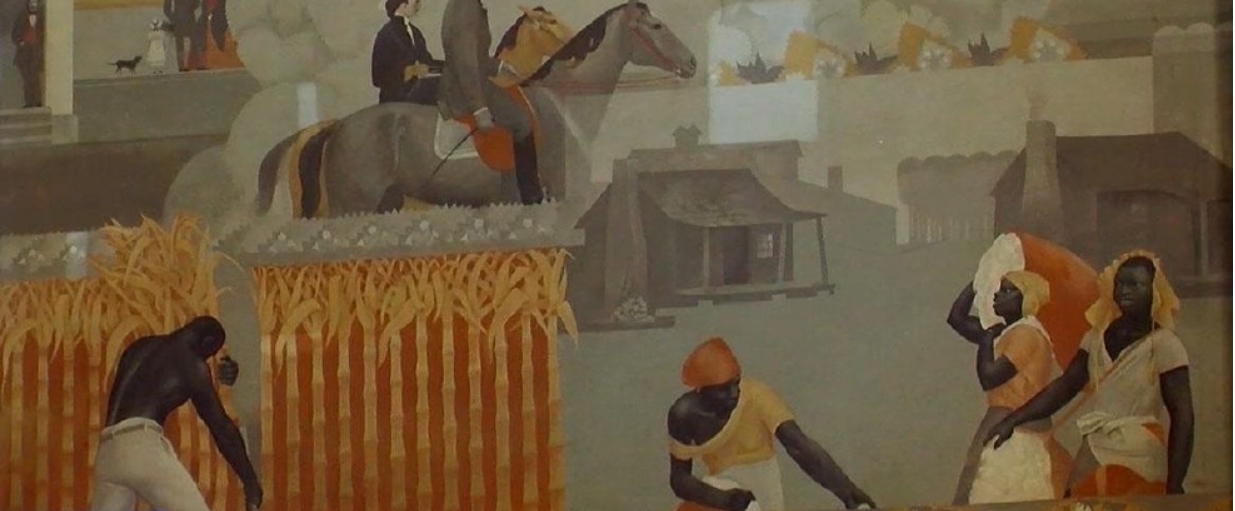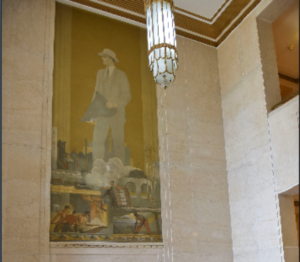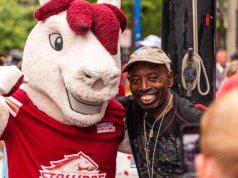By Nick Patterson
The Birmingham Times

A Jefferson County Commission Committee approved paying an Alabama artist to create a new mural to add to the controversial, Jim Crow-era murals already in the county courthouse and, in the words of Commissioner Sandra Little Brown, “bring us up from slavery.”
The commission is expected to pay artist Dr. Ronald McDowell $50,000 to create the new mural, which will display a more diverse, up-to-date depiction of the county and its people, Brown said. Flanked by the original murals, which depict whites in dominant positions over subservient black workers (among other images) in Jefferson County’s past, the new mural will be directly in front of the doors where most people enter the building, on the Linn Park side.
“This mural will reflect today,” Brown said, adding that the earlier “Old South” and “New South” murals, painted in 1931 by Chicago artist John W. Norton really only show a stylized vision that “stops history” long before civil rights era changes that improved the standing of blacks in the community. “We’re up from slavery,” Brown said. “The story’s incomplete.”
In addition to the new mural, which will include images of black and white Lady Justice figures, black and white county judges, and the county seal, informational plaques putting the Norton murals in context will be added as well, Brown said. “It’s diversity,” she said. “Black and white working together for a better Jefferson County.”
McDowell is expected to create the new mural at a location other than the county courthouse. It will then be installed at the courthouse by a display company, Brown said. The new mural is expected to be ready for public viewing by Black History Month, Feb. 2018.
The nation in recent weeks has seen numerous protests about Confederate monuments and various symbols tied to white supremacy. The most notable may be the deadly clash between white supremacists and counter protesters in Charlottesville, VA that left one woman dead, and a Nazi sympathizer charged with ramming her with his car while attacking demonstrators.
But the controversy over the Jefferson County murals dates back for many years, and came to a head in 2015 after protests in Ferguson, MO, and Baltimore, among other places in the aftermath of several well-publicized cases of blacks dying violent deaths in encounters with police officers.

At the time, criticism of the Norton murals came from the NAACP as well as individuals like Anne Garland Mahler, who started an online petition demanding that the murals be taken down at once. “These murals were painted in 1931-32 in the midst of Jim Crow, and they both romanticize a hierarchy of labor in which black people are positioned at the lowest level,” her petition stated.
The petition led to counter complaints that removing the murals would amount to whitewashing history. “It is a sensitive issue,” Brown said.
The county responded by creating a 17-member committee tasked with figuring out what to do with the murals, whether to take them down or to erect contextual signage or to supplement the old art with new. Ultimately, though, the county commission selected the artist, Brown said, adding that the commissioners unanimously approved the working arrangement in subcommittee.
The sculptor and painter chosen to create the new mural, McDowell, has left his artistic imprint on Birmingham before in several pieces of public art, including the statue of Nina “Miss Nina” Miglionico, a longtime city leader, in Linn Park, a statue of Temptations member and Birmingham-native Eddie Kendricks, and a statue honoring civil rights foot soldiers in Kelly Ingram Park. McDowell has also painted a portrait of every musician inducted into the Alabama Music Hall of Fame.
“He’s no stranger to Birmingham,” Brown said. “He has a heart for Birmingham.”
Brown said that the Jefferson County Mural Committee may be reconvened to assist the county as it prepares to celebrate its centennial in 2018.




